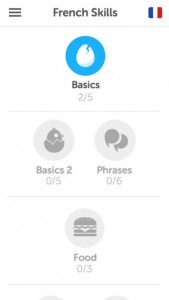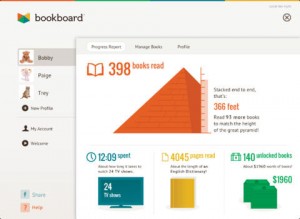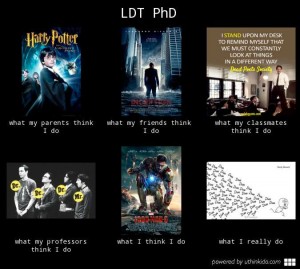For the final project, my primary goal is to create a new app that can support students’ collaboration and interaction in the learning process within one subject matter. However, I know my knowledge and experience concerning the design principle of a successful mobile app is not sufficient to support me in creating a well-designed one. Therefore, for this week’s reading, I selected materials that are related to mobile app design principles and social interactive features.
Young students using iPads: App design and content influences on their learning pathways, by Fallon (2013), employs qualitative methodology (case study method) to examine how the design and content features of mobile apps used on iPads impact young students’ learning pathways when using iPads independently for problem solving tasks. On of the feature for the research design, as indicated by Fallon, was the recording method which resorts to a beta-release open-marketplace app, Display Recorder, to record learners trajectory and activities with selected 45 mobile apps for data analysis. After data collection and analysis, Fallon categorizes the findings into three concepts: content and design features supporting learning, content and design features impeding learning, and design parameters and learning. At the end of the paper, Fallon (2013) proposes careful attention should be paid to the design and content of mobile apps if the undisputed motivation from using mobile devices, including iPads, iPhone, and etc., is to be transformed into thoughtful engagement and productive learning. The quotes below are from Fallon’s paper (2013) but I think it is illuminative to the design of mobile apps:
-
communicating learning objectives in ways young students can access and understand;
-
providing smooth and distraction-free pathways towards achieving goals;
-
including accessible and understandable instructions and teaching elements;
-
incorporating formative, corrective feedback;
-
combining an appropriate blend of game, practise and learning components;
-
providing interaction parameters matched to the learning characteristics of the target student group (pp. 519).
A comparative analysis of a game-based mobile learning model in low-socioeconomic communities of India, by Kim et al. (2012) explores how children living in underdeveloped regions, with low levels of exposure to technology, come to use and learn from mobile technology, while also investigating which factor promote self-directed learning from mobile devices. Children’s aptitude with technology is widely considered as much higher than their teachers and the speed of their adoption of technology can be astonishing to researchers. That is also one reason for me to focus my interests in learning with mobile devices for young childhood students. The research recruits 210 children aging from 6-14 years old from two specific community settings, urban slums and rural villages, and both qualitative (grounded theory) and quantitative methods to examine how group size, exposure to technology, and gender impacts their speed of technology adoption. Age is also one factor that designer should consider but for this research it was overlooked because of real-life issues. Through the examination, researchers proposed four phases of technology adoption for young children, exploration, recognition, interaction, and iterations. Besides, findings from this research are also meaningful for macro implementation of learning with mobile devices within a scope, or larger range, of a nation. Children are proven that can be good at technology even though they have seldom exposure to it before and more previous exposure tend to contribute to better mastery of technology. They can solve the problem with better integration and use of technology in a shorter time. However, in the process of mastery, multiple factors like group size, gender, and probably age may affect their process, either impede or accelerate. The key to facilitate the process is the coordination between the design and contents and the learning goals. The research indicate one drawback for the game of Fire Rescue Math (FRM) is the problematic target door. Students are confused with the target door and they cannot figure out what their goals are, which also reflect the role of learning goal in the design of an app or educational game.
The last paper, Social anxiety and technology: Face-to-face communication versus technological communication among teens, by Pierce (2009) mainly investigates teenagers’ use of socially interactive technologies (SITs), such as online social sites, cell phone/text messaging, and instant messaging, as well as the role of anxiety plays on how teenages communicate with others virtually or face-to-face. The findings of this research is meaningful for me because of my focus on the feature of social interaction for design of mobile apps. The research certifies that SITs have been a replacement of face-to-face communication and the use of SITs may reduce the face-to-face interaction. Additionally, as of the social anxiety, findings provide credible reference for designers who intend to create an app specifically targets at one certain group. Girls are more possible to social anxiety and females with social anxiety tend to be more attached with SITs in order to interact with others. Finally, females feel more comfortable with the use of SITs as a way of communication. Further researches concerning how to improve design of social patterns for SITs devices so that males will be more involved in the technological interaction can be expected.
In my opinion, learning with mobile devices features interactivity (social interaction), mobility (seamless learning), convenience (extreme learning), and individuality (self-regulated learning). After reading through all reading materials, I want to further confirm with this idea but one key element for the success of learning with mobile technology is the access to devices and technologies. Unequal access will bring about a great many controversial issues.
Reference:
Falloon, G. (2013). Young students using iPads: App design and content influences on their learning pathways. Computers & Education, 68, 505-521.
Kim, P., Buckner, E., Kim, H., Makany, T., Taleja, N., & Parikh, V. (2012). A comparative analysis of a game-based mobile learning model in low-socioeconomic communities of India. International Journal of Educational Development, 32(2), 329-340. Elsevier Ltd. doi:10.1016/j.ijedudev.2011.05.008
Pierce, T. (2009). Social anxiety and technology: Face-to-face communication versus technological communication among teens. Computers in Human Behavior, 25(6), 1367-1372. Elsevier Ltd. doi:10.1016/j.chb.2009.06.003












